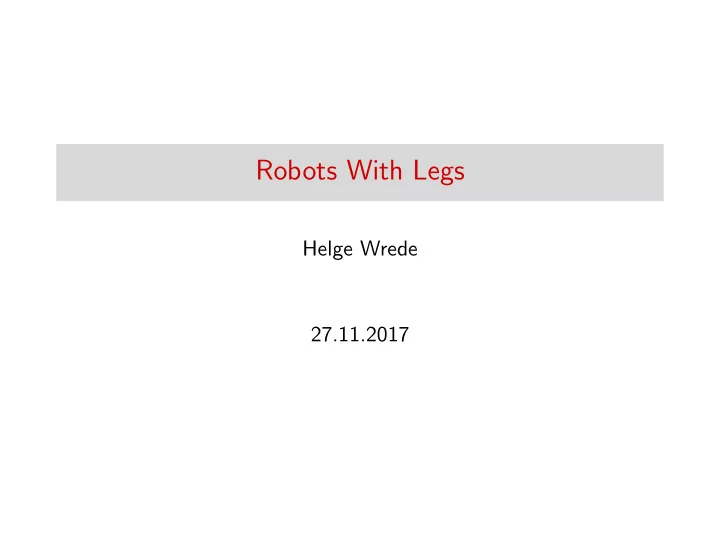

Robots With Legs Helge Wrede 27.11.2017
Outline Motivation Overview Properties Number of legs Balance Walking Basic Bipedal Implementation Dynamic Balancing Concepts 3D-LIPM 2
Motivation Figure: Side view of the Robot Cassie from Agility Robotics [Shelton et al., 2017] 3
Overview Why legs? ◮ World built for humans ◮ Versatility Properties ◮ Number of legs ◮ Gait ◮ Balance ◮ Power usage ◮ Precision 4
Number of legs (a) Bipedal [Simon, 2017] (b) Quadruped [McGlaun, 2017] (c) Hexapod [Elijah, 2017] (d) Octopod [encrust1, 2012] 5
Outline Motivation Overview Properties Number of legs Balance Walking Basic Bipedal Implementation Dynamic Balancing Concepts 3D-LIPM 6
Balance Figure: Example of a hexapedal robot with static balance [Lopes, 2008] 7
Balance Static ◮ Stable all the time ◮ Achieved by leg positioning ◮ Easy to control ◮ At least 4 legs are required Dynamic ◮ Only stable in specific configurations ◮ Achieved by active balancing ◮ Hard to control ◮ Arbitrary number of legs 8
Outline Motivation Overview Properties Number of legs Balance Walking Basic Bipedal Implementation Dynamic Balancing Concepts 3D-LIPM 9
Walking Active ◮ Driven by motors ◮ High precision controlling required ◮ High power usage Passive ◮ Driven by gravity ◮ No controlling needed ◮ No power usage 10
Passive Walkers Figure: Multiple passive walker examples [Collins et al., 2005] 11
Outline Motivation Overview Properties Number of legs Balance Walking Basic Bipedal Implementation Dynamic Balancing Concepts 3D-LIPM 12
Basic Bipedal Implementation Start with passive walker prototype Figure: Passive Walker Prototype [Fong, 2005] 13
Basic Bipedal Implementation Add artificial gravity employing motors and controllers Figure: Motorized Passive Walker [Fong, 2005] 14
Basic Bipedal Implementation Get Combined Walker ◮ Low power usage ◮ Easy to control ◮ Enables smooth motion ◮ Might utilize active balancing to improve stability 15
Outline Motivation Overview Properties Number of legs Balance Walking Basic Bipedal Implementation Dynamic Balancing Concepts 3D-LIPM 16
Dynamic Balancing Concepts ◮ Center of Mass ◮ Support Polygon ◮ Zero Moment Point ◮ Stability Region ◮ Inverted Pendulum 17
Dynamic Balancing 3D Linear Inverted Pendulum Model Figure: Simple schematic representation of a 3D linear inverted pendulum [Koolen et al., 2012] 18
Dynamic Balancing 3D Linear Inverted Pendulum Model Figure: Topview of a generated walking pattern for a straight line [Kajita et al., 2001] 19
Dynamic Balancing 3D Linear Inverted Pendulum Model Figure: Topview of the motion and acceleration of the point mass of a generated walking pattern for a straight line [Kajita et al., 2001] 20
References I [Collins et al., 2005] Collins, S., Ruina, A., Tedrake, R., and Wisse, M. (2005). Efficient bipedal robots based on passive-dynamic walkers. Science , 307(5712):1082–1085. [Elijah, 2017] Elijah, J. (2017). A hexapod robot for national instruments. https://www.kapek.org/blog/ni-hexapod . [Online; accessed 22.11.2017]. [encrust1, 2012] encrust1 (2012). Pointless robot - building a sophisticated robot scorpion. http://pointless-robot.blogspot.de/ . [Online; accessed 22.11.2017]. [Fong, 2005] Fong, M.-f. (2005). Mechanical design of a simple bipedal robot.
References II [Kajita et al., 2001] Kajita, S., Kanehiro, F., Kaneko, K., Yokoi, K., and Hirukawa, H. (2001). The 3d linear inverted pendulum mode: a simple modeling for a biped walking pattern generation. In Proceedings 2001 IEEE/RSJ International Conference on Intelligent Robots and Systems. Expanding the Societal Role of Robotics in the the Next Millennium (Cat. No.01CH37180) , volume 1, pages 239–246 vol.1. [Koolen et al., 2012] Koolen, T., De Boer, T., Rebula, J., Goswami, A., and Pratt, J. (2012). Capturability-based analysis and control of legged locomotion, part 1: Theory and application to three simple gait models. The International Journal of Robotics Research , 31(9):1094–1113.
References III [Lopes, 2008] Lopes, G. (2008). Rhex: a reliable hexapedal robot. https://commons.wikimedia.org/wiki/File:Rhex.jpg . [Online; accessed 27.11.2017]. [McGeer et al., 1990] McGeer, T. et al. (1990). Passive dynamic walking. I. J. Robotic Res. , 9(2):62–82. [McGlaun, 2017] McGlaun, S. (2017). Unitree robotics shows off laikago quadruped robot. https://www.slashgear.com/unitree-robotics-shows- off-laikago-quadruped-robot-17504306/ . [Online; accessed 22.11.2017].
References IV [Shelton et al., 2017] Shelton, D., Hurst, J., and Jones, M. (2017). Agility robotics. http://www.agilityrobotics.com . [Online; accessed 22.11.2017]. [Simon, 2017] Simon, M. (2017). Boston dynamics’ atlas robot does backflips now and it’s full-tilt insane. https: //media.wired.com/photos/5a0e13169639c5682ccdf3b2/ master/w_1183,c_limit/Atlas-FinalArt.jpg . [Online; accessed 22.11.2017].
Appendix - Passive Walkers (a) Front (b) Side Figure: Schematic of a passive walker seen from the front and from the side on a slope [Fong, 2005]
Appendix - Dynamic Balancing 3D Linear Inverted Pendulum Model Figure: Topview of a generated walking pattern for a circle [Kajita et al., 2001]
Appendix - Dynamic Balancing 3D Linear Inverted Pendulum Model Figure: Topview of the simulation results based on the previously generated walking pattern for a circle [Kajita et al., 2001]
Recommend
More recommend